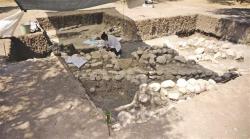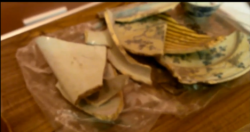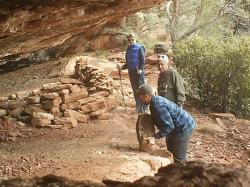INSTITUT SUPERIEUR D'ANTHROPOLOGIE
INSTITUTE OF ANTHROPOLOGY
ONLINE COURSES / COURS A DISTANCE
SPRING TERM : APRIL 2015
REGISTER NOW
TURQUIE –  Apollon Smintheus- Excavations at Apollon Smintheus, located in the northwestern province of Çanakkale’s Ayvacık district, have unearthed a 7,000-year-old tomb. Headed by Professor Coşkun Özgünel, the excavations are being carried out with scientific consultancy from the head of Çanakkale Onsekiz Mart University’s (ÇOMÜ) Archaeology Department, Professor Turan Takaoğlu. Takaoğlu said the tomb, which is a significant finding for the region’s archaeological history, provided crucial information about the burial methods in the region during that ancient era. He said bodies were laid in the tombs in the fetal position. “Ceramics were put next to the bodies as gifts. The tombs were covered with stones randomly. The tombs were discovered for the first time in Smitheus, where prehistoric settlement excavations began in 2004,” he said. The Apollon Smitheus Temple is located in the Bahçeleriçi area, in the skirts of a valley between the northwest and northeast of Gülpınar village in Ayvacık, which was known as Külahlı in the past. It was built in the second half of the 2nd century B.C. and was a sacred place in the Troas region. The pseudodipteral style of the architect Hermogenes was used in the temple’s design. There are eight columns at both the front and back of the temple and 14 columns along its sides. The temple contains three chambers, including a pronaos (sacred front chamber), a naos (sacred room) and an opisthodomos (back chamber), as well as the statue of the god Apollon, made by the sculptor Skopas. According to a book titled “Geographica,” written by famous geographer and traveler Strabo 2,000 years ago, when the Ions came from Greece and surrounded the city, a host of rats came to the surface from underground at night and nibbled their weapons and equipment, which caused the Ions to lose the war. The people of the region then built the temple as a symbol of their appreciation.
Apollon Smintheus- Excavations at Apollon Smintheus, located in the northwestern province of Çanakkale’s Ayvacık district, have unearthed a 7,000-year-old tomb. Headed by Professor Coşkun Özgünel, the excavations are being carried out with scientific consultancy from the head of Çanakkale Onsekiz Mart University’s (ÇOMÜ) Archaeology Department, Professor Turan Takaoğlu. Takaoğlu said the tomb, which is a significant finding for the region’s archaeological history, provided crucial information about the burial methods in the region during that ancient era. He said bodies were laid in the tombs in the fetal position. “Ceramics were put next to the bodies as gifts. The tombs were covered with stones randomly. The tombs were discovered for the first time in Smitheus, where prehistoric settlement excavations began in 2004,” he said. The Apollon Smitheus Temple is located in the Bahçeleriçi area, in the skirts of a valley between the northwest and northeast of Gülpınar village in Ayvacık, which was known as Külahlı in the past. It was built in the second half of the 2nd century B.C. and was a sacred place in the Troas region. The pseudodipteral style of the architect Hermogenes was used in the temple’s design. There are eight columns at both the front and back of the temple and 14 columns along its sides. The temple contains three chambers, including a pronaos (sacred front chamber), a naos (sacred room) and an opisthodomos (back chamber), as well as the statue of the god Apollon, made by the sculptor Skopas. According to a book titled “Geographica,” written by famous geographer and traveler Strabo 2,000 years ago, when the Ions came from Greece and surrounded the city, a host of rats came to the surface from underground at night and nibbled their weapons and equipment, which caused the Ions to lose the war. The people of the region then built the temple as a symbol of their appreciation.
www.hurriyetdailynews.com/tomb-reveals-burial-methods-of-ancient-age.aspx?pageID=238&nid=77243&NewsCatID=375
ROYAUME UNI –  Londonderry - The oldest building in Londonderry, believed to have been burnt down in Cahair O’Doherty’s 1608 rebellion, has been uncovered. Details of the building, only a small part of which has survived, pre-dates the Siege and is the oldest dated building in the city. It had stone foundations and a cellar above which the upper floors were constructed of timber. When the building burnt down its wooden walls and roof collapsed into the cellar where they have now been found, over four centuries later. A collection of artefacts was also unearthed during the dig including musket balls, a small cannon ball, pottery sherds, clay pipes and, a rarity on archaeological excavations, a number of intact wine bottles. The earlist find was a sherd of pottery possibly dating as far back 1200.
Londonderry - The oldest building in Londonderry, believed to have been burnt down in Cahair O’Doherty’s 1608 rebellion, has been uncovered. Details of the building, only a small part of which has survived, pre-dates the Siege and is the oldest dated building in the city. It had stone foundations and a cellar above which the upper floors were constructed of timber. When the building burnt down its wooden walls and roof collapsed into the cellar where they have now been found, over four centuries later. A collection of artefacts was also unearthed during the dig including musket balls, a small cannon ball, pottery sherds, clay pipes and, a rarity on archaeological excavations, a number of intact wine bottles. The earlist find was a sherd of pottery possibly dating as far back 1200.
VIDEO = http://www.londonderrysentinel.co.uk/news/local-news/window-on-the-past-from-city-s-oldest-building-1-6536603
BULGARIE - Krepcha - The oldest preserved Cyrillic inscription was discovered at the "All Bulgarian Saints" rock monastery near the village of Krepcha in the Bulgarian municipality of Opaka. According to prominent Bulgarian archaeologist Nikolay Ovcharov, the inscription was made by the monk Antoniy in 921, who had most likely founded the monastery, Darik radio reports. Prior to this discovery, the oldest preserved Cyrillic inscription was identified as being the one found in the former Bulgarian capital of Veliki Preslav by Prof. Dimitar Ovcharov. The inscription, which read “Altsek” and the year 931, had been found on a ceramic vessel in Bulgaria's medieval capital. The reading of the inscription discovered at the rock monastery near Krepcha has been entrusted to Prof. Kazimir Popkonstantinov of Veliko Tarnovo University. A liturgy was delivered at the rock monastery for the first time in 1100 years on Thursday by priest Serafim. -
http://www.novinite.com/articles/166110/Bulgarian+Archaeologists+Discover+Oldest+Cyrillic+Inscription?
EGYPTE –  - The most famous archaeological relic in the world has been damaged during a botched cleaning attempt. After being knocked off, the blue and gold braided beard on King Tut's burial mask was "hastily" glued back on with an inappropriate adhesive, damaging the item even further.
- The most famous archaeological relic in the world has been damaged during a botched cleaning attempt. After being knocked off, the blue and gold braided beard on King Tut's burial mask was "hastily" glued back on with an inappropriate adhesive, damaging the item even further.
http://io9.com/king-tuts-burial-mask-has-been-irreversibly-damaged-1681085211?
ROYAUME UNI –  Burnby Lane - The most extensive archaeological dig ever undertaken in Pocklington is continuing to unearth extremely rare Iron Age finds, and it could lead to many more exciting discoveries, experts say. About 25 skeletons and 26 square barrows, or burial mounds, from an Iron Age settlement have now been uncovered during the dig, off Burnby Lane. It is believed to be the the largest group of barrows discovered for about 30 years. Some of the barrows have contained pre-historic jewellery, including bangles and brooches, typical of the Arras culture of the middle to late Iron Age in East Yorkshire.
Burnby Lane - The most extensive archaeological dig ever undertaken in Pocklington is continuing to unearth extremely rare Iron Age finds, and it could lead to many more exciting discoveries, experts say. About 25 skeletons and 26 square barrows, or burial mounds, from an Iron Age settlement have now been uncovered during the dig, off Burnby Lane. It is believed to be the the largest group of barrows discovered for about 30 years. Some of the barrows have contained pre-historic jewellery, including bangles and brooches, typical of the Arras culture of the middle to late Iron Age in East Yorkshire.
http://www.pocklingtonpost.co.uk/news/local/more-ancient-finds-unearthed-1-7062357
USA –  Jordan Cave - An investigation is under way to find those responsible for vandalism last month to the Jordan Cave, an archaeological site in Sedona. The cave is estimated to be about 800 years old and was once a dwelling for Native Americans, who still consider the site a scared place. The area is not open to the public, but was disturbed when rocks in the dwelling were tossed over a nearby embankment.
Jordan Cave - An investigation is under way to find those responsible for vandalism last month to the Jordan Cave, an archaeological site in Sedona. The cave is estimated to be about 800 years old and was once a dwelling for Native Americans, who still consider the site a scared place. The area is not open to the public, but was disturbed when rocks in the dwelling were tossed over a nearby embankment.
http://www.azcentral.com/story/news/12-news/2015/01/21/12-news-jordan-cave-vandalized-sedona/22141517/